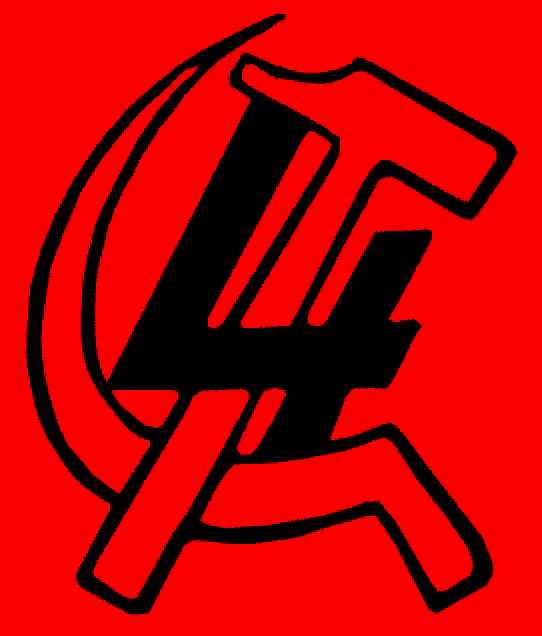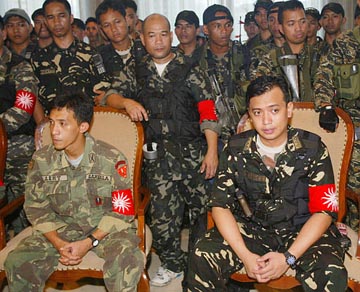
September 2003
Soap Opera “Coup Attempt”
in the Philippines
Perplexities of the July 27 Incident
The following article was written by the Philippine
RKG (Revolutionary Communist Group), which sympathizes with the League for
the Fourth International.
MANILA – “Coup – Coup – Roo – Coup!” the rooster crowed in the early morning
of July 27 as around 200 officers and enlisted men surrounded and took over
the Oakwood Hotel in Makati [the downtown business district of Manila]. The
“mutineers” (as some of the bourgeois press labeled them) called themselves
the “Magdalo Group” – in reference to the Magdalo faction of Emilio Aguinaldo,
one of the leaders of the Katipunan [the clandestine group fighting against
the U.S. invaders] during the bourgeois Philippine Revolution of 1898 – and
come from all the services of the Armed Forces of the Philippines (AFP). Its
leaders are junior officers of the AFP (from the rank of captain on down).
The group itself was comprised mainly of the highly skilled, specialized branches
of the AFP in the forefront of the Philippine military’s counterinsurgency
campaign.
Army captain Gambala and Navy lieutenants Trillanes
and Maestro-Campo – three of the mutineers’ leaders – demanded that President
Arroyo, Defense Secretary Reyes and Chief of the Intelligence Service of the
AFP (ISAFP) Corpus step down. (Later, before they were “convinced” to “go
back to barracks,” they toned down their demands, asking only for Reyes’ and
Corpus’ heads.) They threw in charges of corruption within the military, specifically
the rampant selling of arms by officials of the Department of National Defense,
particularly Reyes, and in the AFP. The junior officers claimed these arms
had ended up in the hands of the leftist and Muslim insurgents they were
fighting.
 Philippines
“coup plotters” Gambala (seated left) and Trillanes (right) in press conference,
July 27. Armbands bore symbol of Filipino independence fighters against
U.S. invasion in 1898. Yet mutineers accuse generals of undercutting war
on leftist and Muslim insurgents. (Photo: Bullit Marques/AP)
Philippines
“coup plotters” Gambala (seated left) and Trillanes (right) in press conference,
July 27. Armbands bore symbol of Filipino independence fighters against
U.S. invasion in 1898. Yet mutineers accuse generals of undercutting war
on leftist and Muslim insurgents. (Photo: Bullit Marques/AP)
They also accused certain senior officials of the
AFP of orchestrating bombings and attacks on the Muslim populace in Mindanao
that would later be blamed on the Moro Islamic Liberation Front (MILF) and
other “terrorist groups.”
As the hours progressed, the “coup plotters” (as
others in the bourgeois media termed them) and Arroyo’s regime were both adamant
in their positions, refusing to give in to the other’s demands. Arroyo herself
looked gloomy in front of the media as she gave an ultimatum that the mutineers
should surrender by 5 p.m. (later extended to 7 p.m.). Senators, among them
opposition leader Gregorio Honasan, and several retired generals were scrambling
in negotiating for a peaceful resolution of the “conflict.”
By 7 p.m. (Arroyo’s extended ultimatum), the so-called
mutiny ended as the Magdalo group agreed to return to the barracks provided
that the regime would ensure that participants in the incident (except the
core of officers) would not be persecuted and that the core of the Magdalo
Group alone would take the responsibility. With that dramatic soap opera ending,
the mutiny ended.
Meanwhile, some of the “mainstream” (i.e., fake)
left hurriedly offered their support to the Magdalo Group. The Maoist/Stalinist
Communist Party of the Philippines (CPP) Party Information Bureau issued a
statement tacitly supporting the Magdalo Group. The CPP-PIB noted that “the
CPP agrees with the three main revelations by the rebel AFP officers. In
the group’s statement read this morning by Maj. Gerardo Gambala, the rebel
group exposed the rampant corruption of senior officers, the direct responsibility
of Defense Secretary Reyes and ISAFP Chief Gen. Victor Corpus in the Davao
bombings and the plan of the Arroyo ruling clique to perpetuate itself in
power by means of imposing martial law come August.” The CPP spokesperson,
Gregorio Rosal, called on “military officers and enlisted men with legitimate
grievances to ‘further deepen their understanding of the why the AFP is on
a losing course and why the revolutionary people’s war is on the correct and
winning course and is widely supported by the people’.” He also called on
“junior officers who are truly and sincerely pro-people to ‘emulate the tradition
of Lt. Crispin Tagamolila and join the revolutionary movement or find ways
to coordinate and cooperate with the revolutionary movement’.” Lt. Tagamolila
of the AFP joined the CPP-led New People’s Army in the 1970s.
On the other hand the Lagmanite trade union center
Bukluran ng Manggagawang Pilipino (BMP – Solidarity of Filipino Workers*)
mobilized about 5,000 people the day after the July 27 incident in conjunction
with Arroyo’s State of the Nation Address to Congress to demand “that the
Arroyo government answer the soldiers’ charges.” Another group, the Stalinist
Partido ng Manggagawang Pilipino (PMP – Party of the Filipino Workers) portrays
the Magdalo group as a bourgeois nationalist group. Ramani da Silva, International
Officer of the PMP, when asked by the Australian reformist Green Left Weekly
(6 August) how he would describe the mutineers’ political perspective,
answered: “They are motivated by a strong nationalist sentiment, but are new
and raw politically.” He also said that the Magdalo Group is a “new generation
of soldiers who are legitimately disgruntled with the conditions within the
military.”
With all the support of the “mainstream left,” even
many ordinary working people tended to view the Magdalo Group as giving a
“new kick” against the traditional carnival-like politics that has been the
natural character of the Philippine political landscape, and some may wonder
if the Magdalo Group is truly revolutionary.
The Rebolusyonaryong Grupo ng mga Komunista warns
that the Magdalo Group recalls mutinies by hard-line junior officers in Latin
American who in the 1980s sometimes staged cuartelazos (barracks revolts),
striking a nationalist posture while calling for intensified counterinsurgency
wars (financed, supplied and advised by the Pentagon) against leftist rebels.
Although the Magdalo Group cannot be compared with the Reform the Armed Forces
Movement (RAM) headed by then colonel Gregorio Honasan that instigated a coup
d’état against the dictator Ferdinand Marcos that eventually was called
EDSA 1 [the so-called “People’s Power” revolt that was actually orchestrated
by the military] in 1986, then later launched several coup attempts against
the Aquino regime during the late ’80s, their class interests are the same
as the RAM – that is, to maintain and strengthen the rule of the local bourgeoisie.
The “mutineers” are first and foremost anti-Communist
and anti-Moro. Proof of this is their deployment in units that are at
the forefront of counterinsurgency operations (like the Light Reaction Company),
urban warfare (“anti-terrorist”) and demolitions, and the fact that their
main demand (corruption in the AFP, etc.) is essentially calling on the AFP
and the bourgeois state itself to wage a tougher and leaner campaign against
the so-called “red menace” and “Moro terrorists.” For revolutionary communists,
it is important to understand the class alignment of forces instead of indiscriminately
throwing support to groups or forces alien to the working class. It is
elementary for communists and any class-conscious worker to know who is the
enemy.
In the case of the Magdalo Group, it is clear that
they are a clique of junior officers and personnel disgruntled at the way
their corrupt superiors in the AFP and the government handled the counterinsurgency
program. They are not a “new generation” of soldiers “legitimately disgruntled
with the conditions,” as the PMP claims. Their so-called “coup d’état,”
:mutiny,” or whatever the bourgeois press calls their Oakwood take-over sought
to strengthen the institutions (specifically the AFP) that preserve and protect
the ruling class and the exploitative capitalist system. By launching a soap
opera “mutiny,” they sought to pressure the bourgeois state to wage a leaner
and tougher offensive against its “enemies” (i.e., the working class, the
Moro peoples and all the oppressed).
It is quite a wonder that the so-called “mainstream
left” like the CPP, PMP, and the BMP have thrown their support to this anti-communist
bunch of military officers. These “mainstream leftists,” satisfying their
opportunist popular-front program, decided to embrace the Magdalo Group to
help them to “further deepen their understanding,” as if the Magdalo Group
did not understand that their enemy are the workers, and all the oppressed!
The host of fake left groups that see the “mutineers”
as “nationalists” try to cover their eyes, ears and mouths from the truth,
namely that every “alliance” the working class makes with so-called “progressive
and nationalist military forces,” results in the bloody defeat and destruction
of the working class (Stalin’s alliance with Chiang Kai-shek in China in 1925-27,
leading to the Shanghai massacre of April 1927; the Indonesian CP’s support
to Sukarno, leading to the slaughter of 1 million leftists and unionists in
1965; and Allende’s illusions in “constitutionalist” military officers led
by Pinochet in Chile that led to the bloody Santiago coup in September 1973
are only some of the examples on this long list). It is no wonder that these
“leftists” have repeatedly been outflanked by the bourgeois opposition in
EDSA 1 (led by the “yellow movement” of the late CIA-boy Benigno Aquino together
with Enrile and Ramos) in 1986 and EDSA 2 in 2001 (led by Arroyo, Ramos,
de Venecia and the pro-capitalist Council for Philippine Affairs).
The key for the working class and revolutionary-minded
militants concerning the July 27 incident is to clearly see the need to break
with the “tradition” of making allies with a faction of the bourgeoisie, and
the need to break with the fake left that keeps making these popular-front
alliances with the bourgeoisie. The RGK fights against this treacherous “tradition”
and seeks to build a genuinely revolutionary vanguard party of the working
class that will lead in the struggle for the workers to expropriate their
class enemy, the bourgeoisie (including the various bourgeois opposition factions).
The road towards decisive victory of the working class is through the Trotskyist
program of permanent revolution – the program of the Russian October Revolution
of 1917 – against the Stalinist and social-democratic class collaboration
and popular-front alliances as the CPP, PMP and the BMP do.
The RGK calls on workers, women and revolutionary-minded
individuals who clearly see the elementary difference between the class interests
of the anti-Communist forces that participated in the July 27 incident and
the bankrupt opportunist politics of the fake left to contact us at rgk7@hotmail.com
or at internationalistgroup@msn.com or visit the www.internationalist.org
website to learn more.
September 20, 2003
Central Group, Rebolusyonaryong Grupo ng mga Komunista
*Filemon (“Popoy”) Lagman, head of the BMP union
federation and a former leader of the PCP, was assassinated in February 2001.
To contact the Internationalist Group and the League for the Fourth International, send e-mail to: internationalistgroup@msn.com